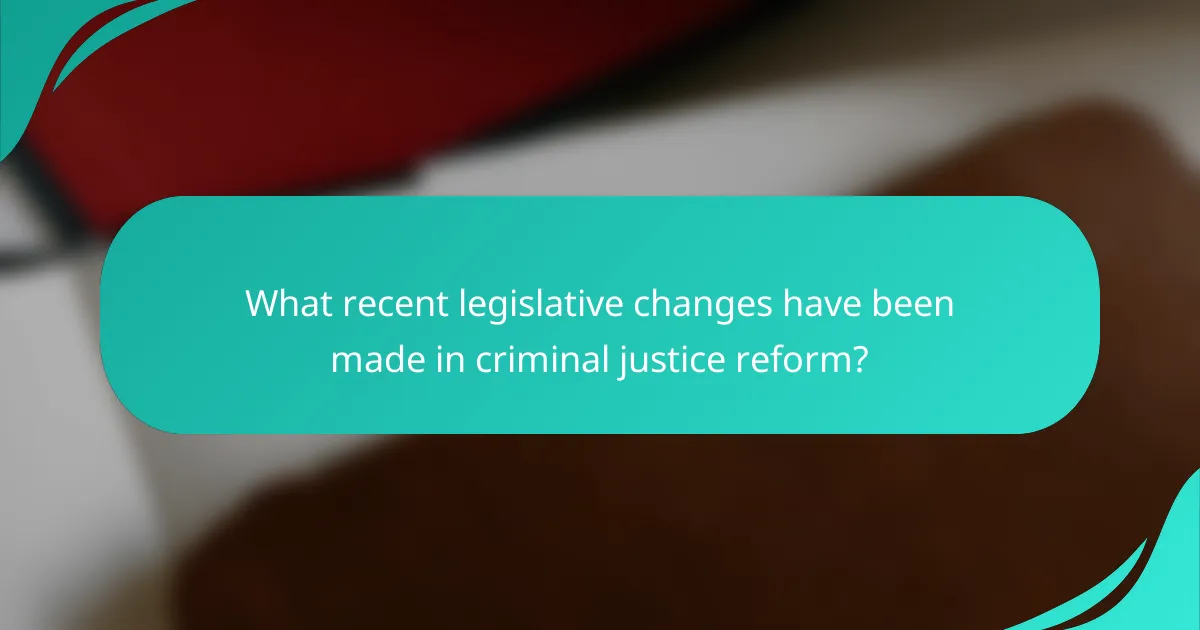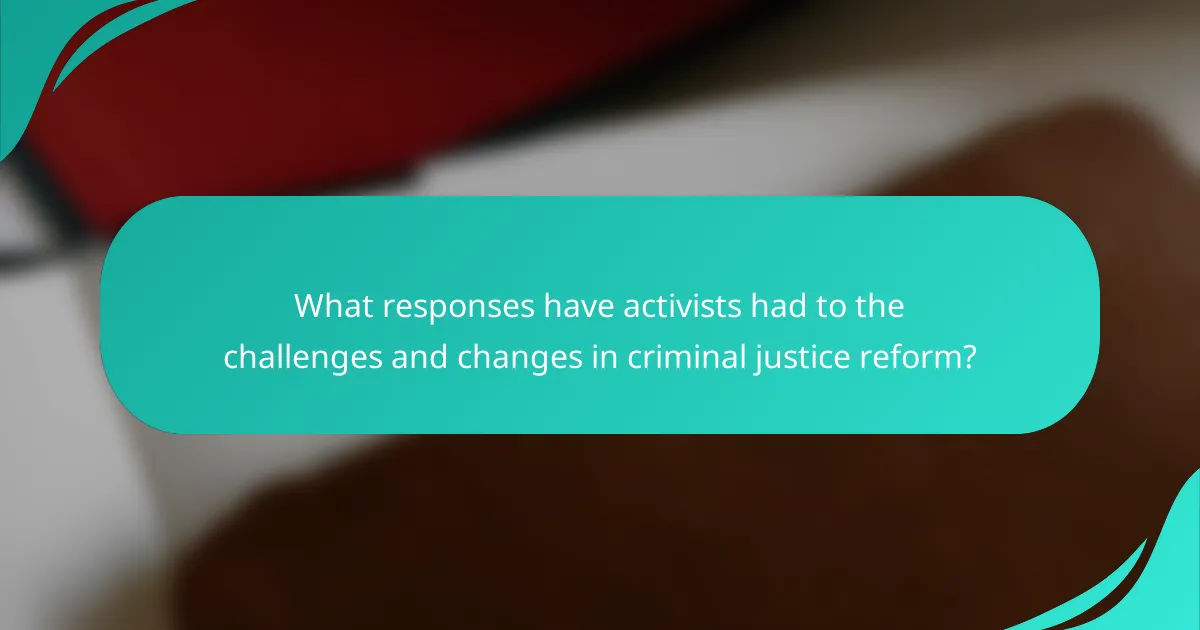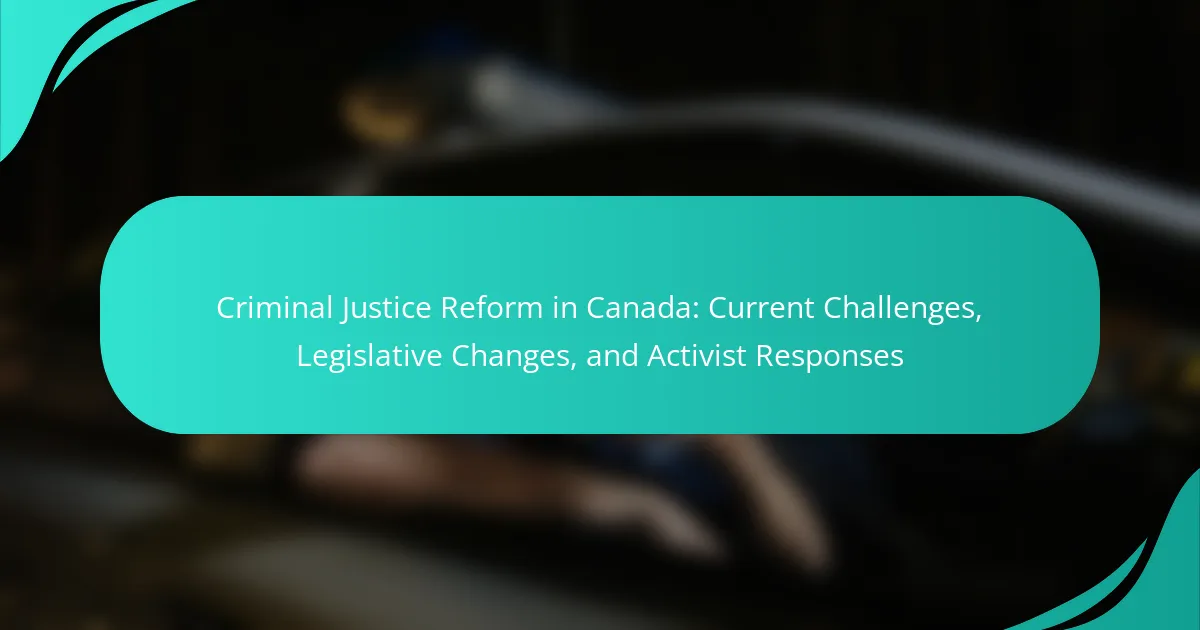
What are the current challenges facing criminal justice reform in Canada?
Current challenges facing criminal justice reform in Canada include systemic racism, over-incarceration, and inadequate mental health resources. Systemic racism affects Indigenous and racialized communities disproportionately. The incarceration rate for Indigenous peoples is over five times higher than that of non-Indigenous Canadians. Overcrowded prisons exacerbate the issue, leading to poor living conditions and increased recidivism. Mental health resources are often insufficient for those within the justice system. Many individuals do not receive the necessary support, which can lead to cycle of reoffending. Additionally, public safety concerns complicate reform efforts. Balancing community safety with the need for rehabilitation is a persistent challenge. These factors create significant barriers to achieving effective reform in the Canadian criminal justice system.
How do systemic issues impact the effectiveness of the criminal justice system?
Systemic issues significantly undermine the effectiveness of the criminal justice system. These issues include racial bias, socioeconomic disparities, and institutional corruption. Racial bias leads to disproportionate targeting of minority communities. Statistics show that Indigenous people in Canada are overrepresented in incarceration rates. Socioeconomic disparities affect access to legal representation and fair trials. Individuals from lower-income backgrounds often cannot afford quality defense. Institutional corruption can erode public trust in law enforcement and judicial processes. Reports indicate that communities with high corruption levels experience increased crime rates. Collectively, these systemic issues create a cycle of mistrust and inefficiency within the criminal justice system.
What role does racial inequality play in the criminal justice system?
Racial inequality significantly impacts the criminal justice system. It manifests in various ways, including disparities in arrest rates, sentencing, and incarceration. Studies show that racial minorities, particularly Indigenous and Black populations, face higher arrest rates compared to their white counterparts. For instance, Indigenous peoples represent approximately 30% of the federal prison population in Canada, despite being only about 5% of the overall population.
Additionally, racialized individuals often receive harsher sentences for similar offenses. Research indicates that Black Canadians are more likely to be sentenced to prison than white Canadians for comparable crimes. This systemic bias contributes to a lack of trust in law enforcement and the judicial system among marginalized communities.
The overrepresentation of racial minorities in the criminal justice system highlights the urgent need for reform. Efforts to address these inequalities include legislative changes and community-led initiatives aimed at promoting equity and justice.
How does socio-economic status affect access to justice?
Socio-economic status significantly affects access to justice. Individuals with lower socio-economic status often face barriers to legal representation. They may lack the financial resources to hire lawyers or pay court fees. This leads to underrepresentation in legal proceedings. Research shows that low-income individuals are less likely to pursue legal action. For example, a study by the Canadian Bar Association found that cost is a major deterrent in accessing legal services. Additionally, those with limited education may struggle to navigate the legal system. This can result in a lack of understanding of their rights and available remedies. Consequently, socio-economic disparities create unequal opportunities for justice.
What are the key criticisms of the existing criminal justice policies?
Key criticisms of existing criminal justice policies include systemic racism, over-incarceration, and inadequate mental health support. Systemic racism manifests in disproportionate incarceration rates among Indigenous and Black populations. Over-incarceration is highlighted by Canada having one of the highest incarceration rates in the world, with a 2019 statistic showing over 38,000 individuals in federal custody. Inadequate mental health support is evident, as many individuals in the justice system suffer from untreated mental health issues, with 25% of incarcerated individuals reporting mental health disorders. Critics argue that these policies fail to address root causes of crime and do not prioritize rehabilitation.
How do mandatory minimum sentences impact incarceration rates?
Mandatory minimum sentences increase incarceration rates significantly. These laws require judges to impose fixed prison terms for specific offenses. This limits judicial discretion in sentencing. As a result, more individuals receive longer sentences. Data from the Canadian Sentencing Commission indicates that mandatory minimums contribute to a rise in prison populations. In Canada, the use of mandatory minimums has led to increased incarceration rates among non-violent offenders. Studies show that these sentences disproportionately affect marginalized communities. This creates a cycle of incarceration that is difficult to break. Overall, mandatory minimum sentences directly correlate with higher incarceration rates.
What are the implications of over-policing in marginalized communities?
Over-policing in marginalized communities leads to increased distrust between residents and law enforcement. This phenomenon contributes to a cycle of criminalization and social exclusion. Marginalized groups often experience higher rates of surveillance and arrests, exacerbating feelings of vulnerability. Studies have shown that over-policing does not correlate with lower crime rates. Instead, it can lead to community trauma and mental health issues. For instance, a report by the Canadian Civil Liberties Association highlights the negative impact of aggressive policing tactics. Over-policing also diverts resources from community support services. This results in a lack of investment in education, health, and social services. Ultimately, over-policing undermines community cohesion and perpetuates systemic inequalities.

What recent legislative changes have been made in criminal justice reform?
Recent legislative changes in criminal justice reform in Canada include the introduction of Bill C-22. This bill aims to decriminalize simple drug possession and reduce mandatory minimum sentences for certain offenses. Additionally, amendments to the Youth Criminal Justice Act have been proposed to focus more on rehabilitation. The government has also committed to addressing systemic racism in the justice system. These changes reflect a shift towards a more restorative approach in criminal justice. The reforms are part of a broader effort to improve community safety and support marginalized populations.
What new laws have been enacted to address criminal justice reform?
Recent laws enacted to address criminal justice reform in Canada include the Criminal Records Expungement Act and the Bail Reform Act. The Criminal Records Expungement Act allows individuals to have certain criminal records permanently removed. This law aims to reduce barriers for reintegration into society. The Bail Reform Act introduces changes to the bail system, focusing on reducing pretrial detention rates. This act emphasizes the presumption of innocence and aims to ensure fairer treatment in the judicial process. These legislative changes reflect ongoing efforts to improve fairness and equity in the criminal justice system.
How do these laws aim to reduce incarceration rates?
These laws aim to reduce incarceration rates by implementing alternatives to imprisonment. They promote restorative justice practices. This includes community service and rehabilitation programs. Such measures address underlying issues like addiction and mental health. Evidence shows that these approaches can lower recidivism rates. For example, a study by the Canadian Centre for Justice Statistics indicates that diversion programs significantly reduce repeat offenses. Additionally, these laws emphasize preventative measures. By focusing on crime prevention, they aim to reduce the number of individuals entering the justice system. Overall, these strategies contribute to a more effective and humane criminal justice system.
What measures are being taken to improve rehabilitation and reintegration?
Measures being taken to improve rehabilitation and reintegration include the implementation of community-based programs. These programs focus on providing support services for individuals post-release. They offer job training, mental health services, and substance abuse treatment. Additionally, restorative justice initiatives are being promoted. These initiatives encourage offenders to take responsibility and engage with victims. Legislative changes are also enhancing access to rehabilitation resources. For instance, the Correctional Services Canada has increased funding for educational programs. Studies show that education significantly reduces recidivism rates. Furthermore, partnerships with non-profit organizations are being formed to assist in reintegration efforts. These collaborations help create a supportive environment for individuals transitioning back into society.
How have proposed reforms evolved in recent years?
Proposed reforms in criminal justice in Canada have evolved significantly in recent years. Legislative changes have been influenced by public outcry and advocacy for systemic justice reforms. Recent proposals focus on reducing incarceration rates and addressing racial disparities. The introduction of restorative justice practices has gained traction. Additionally, there is a growing emphasis on mental health support within the criminal justice system. Recent statistics indicate an increase in community-based alternatives to incarceration. Furthermore, discussions around police accountability have intensified, leading to calls for increased transparency. These developments reflect a shift towards a more rehabilitative and equitable justice system.
What role has public opinion played in shaping these reforms?
Public opinion has significantly influenced criminal justice reform in Canada. Public sentiment often drives political agendas and policy changes. For instance, widespread calls for reform have emerged from high-profile cases of police misconduct. These incidents spark national conversations, leading to increased scrutiny of existing laws. Polls indicate that a majority of Canadians support measures aimed at reducing systemic racism in the justice system. Activist movements, fueled by public opinion, have also pressured lawmakers to prioritize reforms. Consequently, this collective voice has led to legislative changes aimed at enhancing accountability and transparency. Overall, public opinion serves as a catalyst for reform, shaping the discourse and legislative action around criminal justice in Canada.
How have different political parties approached criminal justice reform?
Different political parties in Canada have approached criminal justice reform with varying priorities and strategies. The Liberal Party has focused on reducing mandatory minimum sentences and promoting restorative justice. They emphasize rehabilitation over punishment, aiming to address systemic issues within the justice system. The Conservative Party tends to support tougher crime policies, advocating for stricter penalties and increased police funding. Their approach often prioritizes public safety and deterrence. The New Democratic Party (NDP) champions social justice, emphasizing the need for reforms that address racial disparities and mental health issues in the justice system. They advocate for decriminalization of certain offenses and increased community support services. Each party’s approach reflects its underlying values and constituency concerns, shaping the ongoing discourse on criminal justice reform in Canada.

What responses have activists had to the challenges and changes in criminal justice reform?
Activists have responded to challenges in criminal justice reform by organizing protests and advocacy campaigns. They aim to raise awareness about systemic issues. Activists also engage in lobbying efforts to influence policy changes. They collaborate with community organizations to support marginalized groups affected by the justice system. In Canada, groups like Black Lives Matter have highlighted racial disparities in policing and sentencing. Activists utilize social media to mobilize support and share information. They also participate in public consultations to voice their concerns directly to lawmakers. These efforts have led to increased public discourse on necessary reforms.
How are grassroots organizations influencing criminal justice reform?
Grassroots organizations are significantly influencing criminal justice reform by mobilizing communities and advocating for policy changes. They raise awareness about systemic injustices within the criminal justice system. These organizations often provide education and resources to affected individuals. They also engage in direct action, such as protests and campaigns, to draw attention to specific issues. For example, groups like Black Lives Matter Canada advocate against police violence and racial profiling. Their efforts have led to increased public discourse on these topics. Additionally, grassroots organizations often collaborate with policymakers to propose legislative changes. This collaborative approach has resulted in reforms aimed at reducing incarceration rates and promoting restorative justice practices.
What strategies are being employed to raise awareness about reform issues?
Strategies employed to raise awareness about reform issues include public campaigns, social media outreach, and community engagement. Public campaigns utilize advertisements and informational materials to inform citizens. Social media outreach leverages platforms like Twitter and Facebook to disseminate information rapidly. Community engagement involves organizing town halls and forums for direct dialogue. Advocacy groups often collaborate with local organizations to amplify their messages. Research shows that grassroots movements significantly increase public awareness and support for reform initiatives. For instance, the Canadian Civil Liberties Association has effectively used these strategies to highlight issues in the criminal justice system.
How do activists work to hold the government accountable for reforms?
Activists hold the government accountable for reforms through advocacy, public campaigns, and legal action. They organize protests to raise awareness about issues within the criminal justice system. Activists also engage in lobbying efforts to influence policymakers directly. They often gather data and research to support their claims and demands. Collaborating with legal experts, they may file lawsuits to challenge unjust laws or practices. Grassroots movements mobilize community support to amplify their voices. Social media platforms are utilized to spread information and connect with broader audiences. By maintaining pressure on government officials, activists push for meaningful legislative changes.
What are the success stories from activist movements in Canada?
Activist movements in Canada have achieved notable successes in various areas. One major success is the decriminalization of cannabis. This change followed years of advocacy by organizations like the Canadian Drug Policy Coalition. Their efforts culminated in the Cannabis Act of 2018, which legalized recreational use.
Another significant achievement is the push for Indigenous rights. Movements such as Idle No More have raised awareness about treaty rights and environmental issues. This activism has led to increased government consultations with Indigenous communities.
Additionally, the campaign for the abolition of mandatory minimum sentences has made strides. Groups like the Criminal Lawyers’ Association have advocated for reform. Their efforts contributed to the 2019 Supreme Court decision that struck down certain mandatory minimum sentences as unconstitutional.
These examples illustrate how activist movements in Canada have influenced legislative changes and public policy.
How have community-led initiatives improved local justice outcomes?
Community-led initiatives have improved local justice outcomes by fostering collaboration between residents and law enforcement. These initiatives enhance trust within communities. They often lead to reduced crime rates and improved reporting of criminal activity. For instance, the Community Mobilization Initiative in Canada has successfully lowered recidivism rates. It emphasizes prevention and intervention strategies tailored to local needs. Data from this initiative shows a 30% decrease in repeat offenses in participating areas. Additionally, community-led programs promote restorative justice practices. These practices focus on repairing harm rather than punitive measures. Overall, community involvement has proven effective in creating safer neighborhoods and more equitable justice processes.
What lessons can be learned from successful activist campaigns?
Successful activist campaigns teach the importance of clear messaging and strong organization. Effective campaigns often have a focused goal that resonates with the public. A well-defined target audience helps tailor messages for maximum impact. Collaboration among diverse groups amplifies voices and resources. Utilizing social media effectively can mobilize support quickly and widely. Successful campaigns also highlight the need for continuous engagement with stakeholders. Data-driven approaches provide credibility and strengthen arguments. Finally, persistence in advocacy is crucial, as change often takes time and sustained effort.
What practical steps can individuals take to support criminal justice reform in Canada?
Individuals can support criminal justice reform in Canada by engaging in advocacy efforts. They can join or support organizations focused on reform, such as the Canadian Civil Liberties Association. Volunteering for these organizations helps amplify their impact. Individuals can also participate in community discussions about justice reform. Attending town hall meetings allows for direct engagement with policymakers. Signing petitions related to justice reform can demonstrate public support for change. Additionally, contacting elected representatives to express concerns about the justice system is crucial. Educating themselves and others on criminal justice issues fosters informed discussions. Supporting restorative justice programs can also lead to meaningful reform initiatives.
The main entity of the article is “Criminal Justice Reform in Canada.” The article outlines the current challenges facing this reform, including systemic racism, over-incarceration, and inadequate mental health resources. It discusses the impact of these issues on the effectiveness of the justice system, particularly regarding racial inequality and socio-economic barriers. Additionally, recent legislative changes aimed at addressing these challenges, along with activist responses and community-led initiatives, are examined. The article emphasizes the importance of public opinion and grassroots movements in shaping criminal justice policies and improving local justice outcomes.




